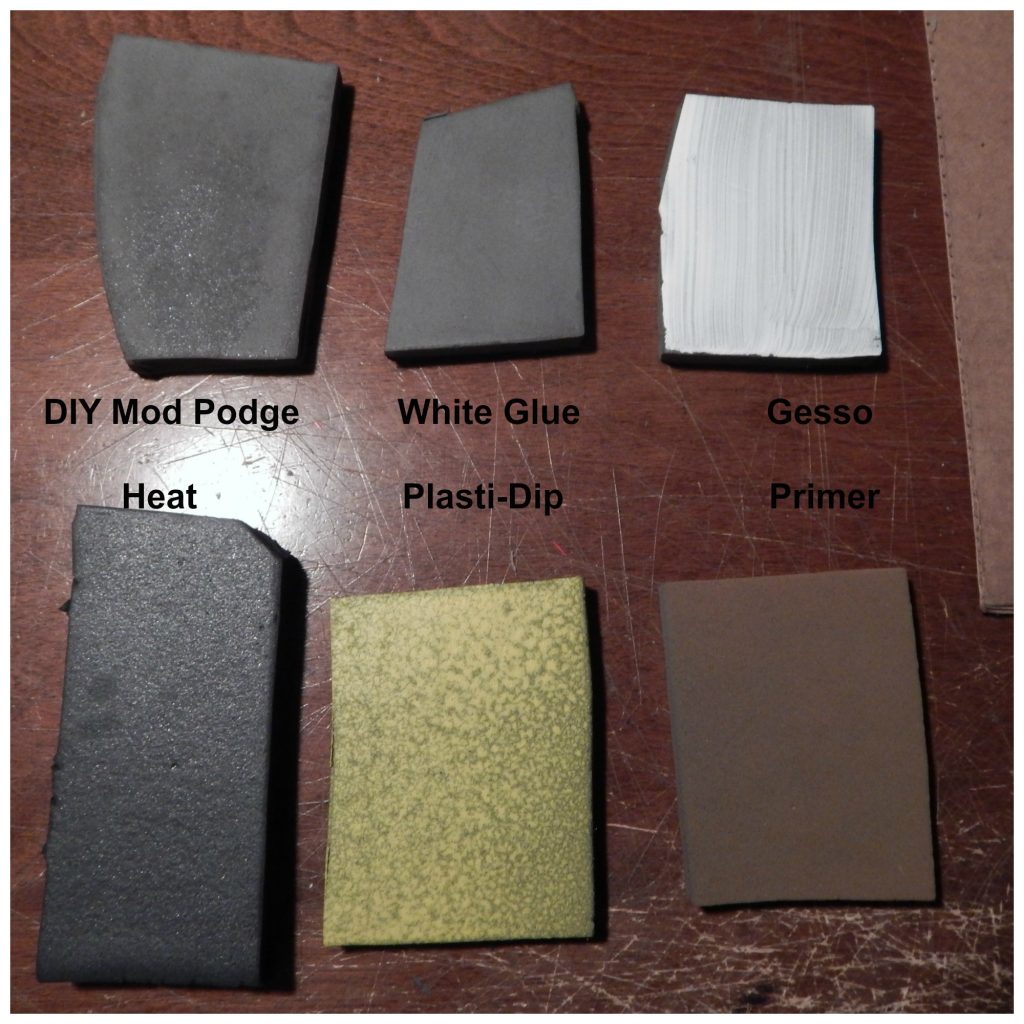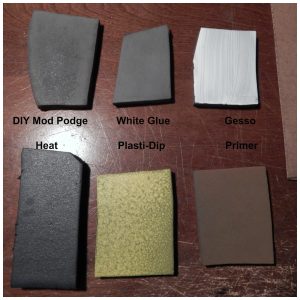Let’s get right into it!
I’ve saved you some time, energy, waiting, and money, and tested out some of the most common ways to prime and seal your EVA foam before painting to help you decided what’s the best method for what you’re building.
Why is this important? While you can absolutely just apply your paint directly to your foam, paint generally tends to be absorbed by the porous surface and this will unnecessarily eat up a lot of product, wasting your time, product, and money. Priming also helps your paint survive wear and tear. Without prepping the surface to accept paint, you can also risk chipping and flaking, ruining the quality of your build.
Firstly, let’s look at the six different methods I’ve used. Each method consists of one coat of the product and a minimum drying time of eight hours, except for the heating method.
Let’s look at the heating method first since it is no cost, assuming you already have a heat gun or, at the very least, a hair dryer. It’s a pretty easy method to use, but can take some time and patience to ensure even heating on larger pieces. Since you’re adding no coating or product to the surface, this method retains the normal feel and flex to the foam. Care should be taken when heating, as it is possible to melt the foam, making it hard, bubbly, and warped.
This is the DIY version of Mod Podge. Unfortunately, with regards to the Mod Podge, I didn’t have any of the brand-name stuff on hand, but I know a lot of folks out there have created and used a DIY recipe of a 1:1 ratio of white school glue and water. This is the recipe I’ve used for this demonstration. As you can see, it still coats the foam well and allows for a good amount of flex with minimal cracking. I would say if your budget is slim and you’re not looking to build your cosplay to endure several hard wears, this would be a comparable dupe to a coat of Plasti Dip.
We’ve now nixed the water part entirely and gone with straight white glue. While it created a nice, smooth finish and appears to seal the foam well, it doesn’t lend itself well to armour parts that require some flexibility. But if you have some rigid components or props which will practically never flex, this might be something to note for a small budget, or for emergencies if you can’t access what you need.
Similar to the white glue, Gesso is awesome for priming. However, if you’re looking for a super-smooth finish, you’ll probably need several coats and some sanding to get the result you’re looking for. This means a lot more time invested in drying between coats and finishing it before you can get to painting. Also, similar to the white glue, this is probably not a great product to use on your flexible components, but better suited for props and rigid pieces.
Spray paint primer is awesome for a variety of reasons: It retains its flexibility, it dries pretty fast, it’s not terribly expensive, and you can get it in colours that will compliment your final paint colour, meaning less coats of paint and less money out of your pocket.
Of all the products, my personal favourite is Plasti Dip. This automotive-turned-cosplay product can be found in most hardware stores and, while the price can be a bit higher than these other methods, definitely yields the best result for armour. If you’ve see my Gogo Tomago cosplay, I’ve worn it to several events and it’s still in pretty good condition. That armour was primed with yellow Plasti Dip and then painted to the desired shade. It creates a plastic-y, rubberized surface that grabs paint well and retains all the flexibility of the foam.
To show you how well these products prime and seal the EVA foam, I’ve applied 2 coats of acrylic paint to each demo piece. As you can see, all of these do a good job of preventing the foam from absorbing the paint. I would say the ones that provide the best priming coverage would be the Gesso, the spray primer, and the Plasti Dip.
Let me know if you have any other methods that I didn’t cover here or if you agree or disagree with the results I’ve shared here.
J. Tanooki is a Contributor for AYBOnline.com. She has been a lover of cosplay for over ten years and regularly works on new and exciting cosplay projects. She actively posts about her cosplay plans, progress, and random shenanigans on her Facebook page, Twitter, and Instagram. Her opinion is her own.










